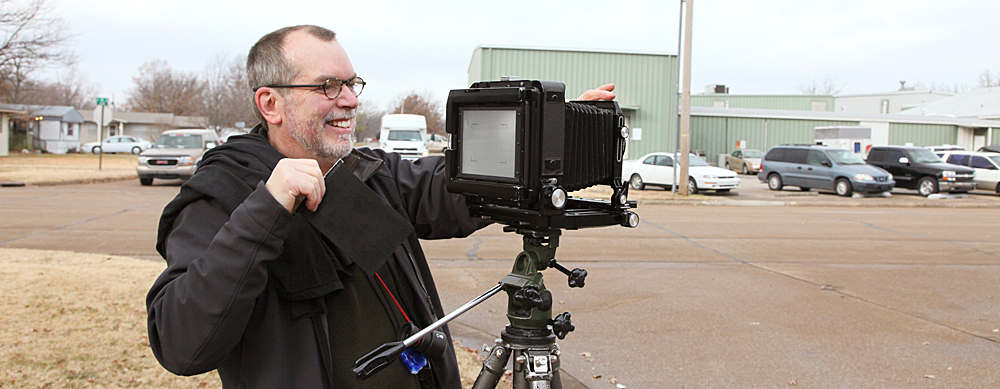
Robert Burley photographing at Dwayne’s Photolab in Parsons, KS on the last day the lab accepted Kodachrome film. Photograph by Henry Wilhelm/2010
In the brief time Robert Burley spent documenting the industrial infrastructure supporting analog photography, the world embraced a digital age. Suddenly a global population abandoned their film cameras and began to create and share photographs using data-driven devices. Companies such as Kodak and Polaroid were reduced to shadows of their former selves, or worse, as they attempted to adapt. Burley traveled the world with his 4×5 field camera to record the film plants that were literally disappearing before his eyes, capturing this technological transition on film before it too vanished.
Burley began the project in Toronto (his home) in 2005 when he discovered the century-old Kodak Canada complex was being shut down. Over a one year period Burley had the opportunity to look “behind the silver curtain” and explore a world that had been secretive about its methods of production up until this time. As he photographed this eighteen-building manufacturing facility and spent time speaking with Kodak employees, he quickly understood that the Toronto plant closing was the tip of the iceberg in relation to the demise of the photographic industry. During this time, Burley, who teaches at Toronto’s Ryerson University also oversaw the transfer of the Kodak Canada Corporate Archives to University’s Special Collections in the library. In addition Burley was Program Director of new graduate program in Photographic Preservation and part of a Ryerson team that was responsible for acquiring the renowned, Black Star Photography Collection. Burley’s work as a photographer and teacher allowed him to better understand that photography, his life’s work, was undergoing radical and dramatic changes that were redefining the medium.
In 2007 he expanded the scope of his project to include other related sites and companies that had been a part of his own personal history with photography. He attended a number of scheduled implosions of factories by the Eastman Kodak Company in Rochester and France, he visited the Agfa Gevaert factory in Antwerp and later returned to Europe again to photograph at Ilford in the UK and the Impossible Project in the Netherlands. Burley also traveled to Boston to photograph Polaroid in 2009 and then went to Parsons, KS in 2010 to photograph at Dwayne’s Photolab – the last lab to process the famed Kodachrome film.
In 2008 and 2009 Burley was invited by the Contact Photography Festival in Toronto and Le Mois de la Photo à Montréal to exhibit selections from this work and undertake large scale photographic installations. In 2012 Burley released, The Disappearance of Darkness: Photography at the end of analog era published by Princeton Architectural Press/New York in association with the Ryerson Image Centre/Toronto.
Starting in 2013, Burley will work with the Ryerson Image Centre to travel two exhibitions of work from this project in Europe and North America. The National Gallery of Canada will open an exhibition in Ottawa and le musée Nicéphore Niépce will open a parallel exhibition in Chalon-sur-Saone, France.
